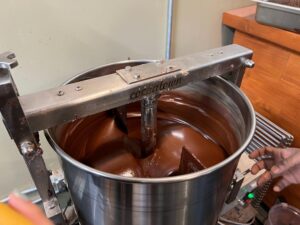Sol Cacao, the first Black-owned chocolate factory in New York City, is on a mission to teach people about the health benefits of chocolate and inspire the next generation of chocolatiers.
The factory was founded by three brothers, Dominic, Nicholas and Daniel Maloney. Growing up, they remember hearing stories from their parents about their great grandparents growing their own food in Trinidad and Tobago. The tales inspired the brothers to follow in their family’s footsteps.
“I think the first sign (that) we would do something with chocolate came when my parents would bring back something called cocoa tea,” Daniel Maloney, 30, said. “We noticed that it was completely different from some of the commercial stuff because it would be oils rising to the top of the hot cocoa and when you have a regular hot cocoa, you tend not to see that.”
In 2016, seven years after moving from Trinidad to the United States, the Maloney brothers opened Sol Cacao. They’ve since moved their offices from Harlem to the Bronx, to the second floor of 780 E. 133rd St.
“What we were trying to do was bring a higher quality of food to the Bronx, and we felt that here it would have made the biggest impact considering that some parts of the South Bronx is a food desert,” Maloney said.
“There isn’t really many supermarkets around so what we wanted to do was at least start creating that catalyst to bring in healthier foods into the neighborhood,” he explained.
Sol Cacao offers four chocolate bars that are made from only three ingredients: cacao beans, cocoa butter and organic cane sugar. The beans are sustainably and ethically sourced from Ecuador, Madagascar and Peru, and the newest edition of chocolate uses beans imported from Colombia, according to the company’s website.
The beans from Madagascar taste like raisins, plums or cherries. The ones from Peru taste like honey with some floral notes. The beans from Ecuador have a savory and toasty flavor profile. Colombian cacao beans taste the most neutral, like almonds or walnuts.
Next on the brothers’ agenda is getting cacao beans from Trinidad, their home country. But those are quite expensive, Maloney said.

The brothers started producing their bars at 70% cocoa to get their customers familiar with the taste. Eventually they may opt for more pure chocolate, which has antioxidants and is good for your heart and brain, and can even work as an antidepressant.
Chocolate in its purest form is not mixed with anything. When it is mixed, the cacao bean is chemically manipulated and stripped of its nutritional benefits, a process known as Dutch processing.
“I think a lot of our work is really demystifying the process and letting people know that chocolate is a superfood,” Maloney said. “It’s actually one of the superest of foods. Period.”
Lorraine Kearney, a certified dietitian nutritionist and the CEO of New York City Nutrition, agrees that chocolate can be part of a balanced diet and adds that it’s a great source of iron, copper, magnesium and phosphorus.
But, she said, people wrongly label food as “good” or “bad,” which leads to overconsumption of foods like chocolate and a “last supper” mentality.
“So, within that setting, typically, people, what they’ll do is overconsume with the belief that they’re never going to have it again,” Kearney said. “But with chocolate, we do have cravings for chocolate from time to time and especially for a woman and their menstrual cycles, too.”
Sol Cacao packages and delivers most of their own chocolate. But they also work with Whole Foods and the Mott Haven cafe Mottley Kitchen, which sells all four of Sol Cacao’s chocolate bars.
Kathryn Creech, the owner of Mottley Kitchen, says her customers are attracted to the story of Sol Cacao and the fact that it’s based in the Bronx.
“It also helps that (the chocolate bars) are vegan, vegan products do very well here,” Creech said.
Sol Cacao was going to start tours of the factory last year, but that was halted because of the coronavirus pandemic. Now, Maloney has been starting to talk at schools to educate students about chocolate making.
“It’s continuing to put the Bronx on the map as a world class chocolate destination,” Maloney said. “And we’re going to do that too, continuing to do the good work that we’ve already started.”

